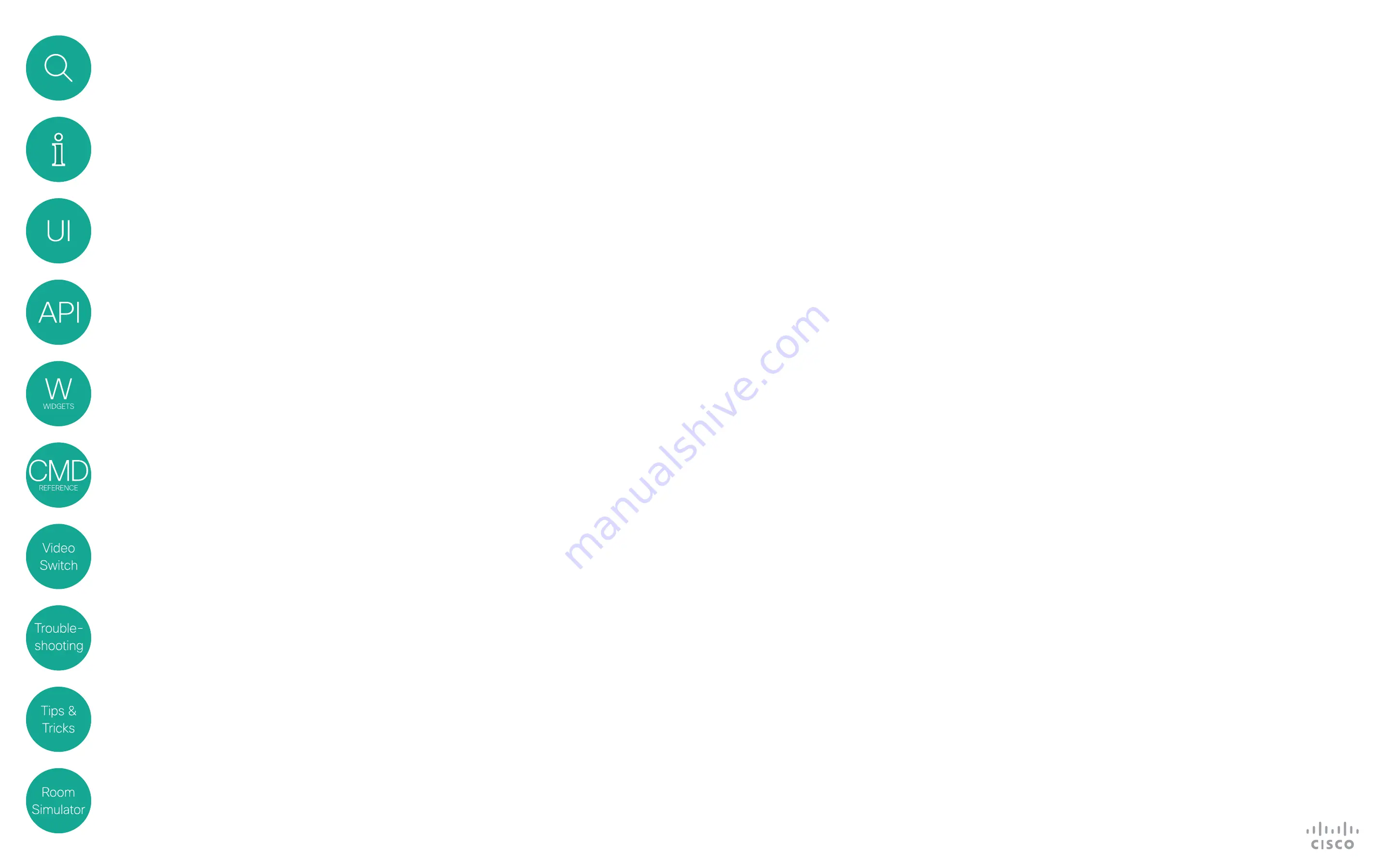
38
D1535805 User Guide In-Room Control for Touch10. Produced June 2017 for CE9.0. © 2015–2017 Cisco Systems, Inc. All rights reserved
Recommended Best Practice
Tips and Tricks
Re-register to Get Feedback After Restart
When either the video system or the control system restarts, the
control system must re-register to the events that the video system
sends when someone uses the Touch10/DX in-room controls or
pushes a new in-room control panel to the Touch10/DX.
For terminal output mode:
xfeedback register event/UserInterface/Extensions/Widget
For XML output mode:
xfeedback register event/UserInterface/Extensions/Event
xfeedback register event/UserInterface/Extensions/Widget/
LayoutUpdated
Consult the API for in-room control chapter for more details.
Initialize All Widgets
Make sure the control system initializes all the widgets on the
Touch10/DX in-room control panel in the following situations:
•
When the control system connects to the video system for the
first time
•
When the video system restarts
•
When the control system restarts
•
When a new in-room control panel is exported to the video
system (as response to a LayoutUpdated event).
If this is not done, then the Touch10/DX may show incorrect
values and not truly reflect the status of the room.
Use the
SetValue
command to set the initial values.
Always send values back to the video system when something
changes.
To avoid unexpected behavior and ambiguities, the control system
must always send
SetValue
commands to the video system when
something changes. This applies also when the change is triggered
by someone using the controls on the Touch10.
For example, it makes no difference if you use a slider on the
Touch10/DX in-control panel to dim the light, or a physical
dimmer in the room, or another touch panel. The control system
must always send the dimmer value back to the video system
using the
SetValue
command.
Update the In-room Control Panel
When you export a new in-room control panel to the video
system, the old panel is overwritten and replaced by the new one.
To update, do as follows:
1. Launch the in-room control editor from the video system’s web
interface.
2. Create the in-room control panel you want, or import a
previously saved panel from file (
Import
>
From file
).
3. Click
Export
>
To codec
.
Other Useful Stuff
Remember previous values when turning lights off (e.g. a light
with a slider for dimming and toggle for on/off), remember the
current light state when turning off, and use that value when
turning back on.
Example:
If the light is at 40%, and the user presses off, she will
expect it to go back to 40% (not 100%) when pressing pressing
the “on” again. Remember also to set the power switch to off if
sliding to 0%.
For blinds, consider using the following strategy:
Short press on
a direction arrow tilts the blinds. If tilted all the way already, moves
the blinds slightly.
Long press on a direction arrow starts moving the blind that
direction, doesn’t stop until blinds are all the way up/down.
To stop movement after long pressing, short press any button
(stop button is not really necessary)
Remove Entire In-room Control Panel and Icon
If there is an in-room control panel on the video system then
there is also a corresponding in-room control icon, either in the
Touch 10/DX status bar or as a button to the right of the call
control buttons. Even if a panel is empty and contains no widgets,
both the icon and the panel will be visible.
Do as follows to remove an in-room control panel and icon
from Touch10/DX:
1. Launch the in-room control editor from the video system’s web
interface.
2. Select the panel to be removed (Global, Homescreen or In-
call)
3. Click
Delete panel
.
Transitioning from 3rd Party Control Systems to CE
If you already have been using a third party control system
and want to start using CE as described in this document, we
recommend the following:
•
Let any programming made to control third party stuff remain
untouched.
•
Remove all code that controls the Cisco video endpoint as that
is now already controlled via the Touch10/DX.
•
Reprogram the signalling from the button-presses coming from
the third party control system panel so that it listens to button
presses from the Touch10/DX instead.
This programming can be very simple to do as the largest control
system manufacturers provide modules/drivers for in-room
Controls making it very easy to get started with the programming.




















